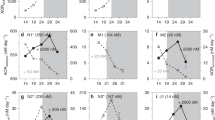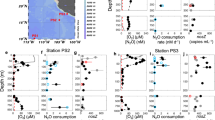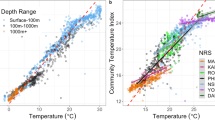Abstract
Large amounts of the greenhouse gas methane are released from the seabed to the water column1, where it may be consumed by aerobic methanotrophic bacteria2. The size and activity of methanotrophic communities, which determine the amount of methane consumed in the water column, are thought to be mainly controlled by nutrient and redox dynamics3,4,5,6,7. Here, we report repeated measurements of methanotrophic activity and community size at methane seeps west of Svalbard, and relate them to physical water mass properties and modelled ocean currents. We show that cold bottom water, which contained a large number of aerobic methanotrophs, was displaced by warmer water with a considerably smaller methanotrophic community within days. Ocean current simulations using a global ocean/sea-ice model suggest that this water mass exchange is consistent with short-term variations in the meandering West Spitsbergen Current. We conclude that the shift from an offshore to a nearshore position of the current can rapidly and severely reduce methanotrophic activity in the water column. Strong fluctuating currents are common at many methane seep systems globally, and we suggest that they affect methane oxidation in the water column at other sites, too.
This is a preview of subscription content, access via your institution
Access options
Subscribe to this journal
Receive 12 print issues and online access
$259.00 per year
only $21.58 per issue
Buy this article
- Purchase on Springer Link
- Instant access to full article PDF
Prices may be subject to local taxes which are calculated during checkout



Similar content being viewed by others
References
Boetius, A. & Wenzhofer, F. Seafloor oxygen consumption fuelled by methane from cold seeps. Nature Geosci. 6, 725–734 (2013).
Reeburgh, W. S. Oceanic methane biogeochemistry. Chem. Rev. 107, 486–513 (2007).
Sansone, F. J. & Martens, C. S. Methane oxidation in Cape Lookout Bight, North Carolina. Limnol. Oceanogr. 23, 349–355 (1978).
Semrau, J. D., DiSpirito, A. A. & Yoon, S. Methanotrophs and copper. FEMS Microbiol. Rev. 34, 496–531 (2010).
Kessler, J. D. et al. A persistent oxygen anomaly reveals the fate of spilled methane in the deep Gulf of Mexico. Science 331, 312–315 (2011).
Mau, S., Blees, J., Helmke, E., Niemann, H. & Damm, E. Vertical distribution of methane oxidation and methanotrophic response to elevated methane concentrations in stratified waters of the Arctic fjord Storfjorden (Svalbard, Norway). Biogeosciences 10, 6267–6278 (2013).
Crespo-Medina, M. et al. The rise and fall of methanotrophy following a deepwater oil-well blowout. Nature Geosci. 7, 423–427 (2014).
Wallmann, K. et al. The global inventory of methane hydrate in marine sediments: A theoretical approach. Energies 5, 2449–2498 (2012).
Knittel, K. & Boetius, A. Anaerobic oxidation of methane: Progress with an unknown process. Annu. Rev. Microbiol. 63, 311–334 (2009).
Kirschke, S. et al. Three decades of global methane sources and sinks. Nature Geosci. 6, 813–823 (2013).
Reeburgh, W. S. et al. Black-Sea methane geochemistry. Deep-Sea Res. I 38, 1189–1210 (1991).
Hanson, R. S. & Hanson, T. E. Methanotrophic bacteria. Microbiol. Rev. 60, 439–471 (1996).
Murrell, J. C. in Handbook of Hydrocarbon and Lipid Microbiology (ed Timmis, K. N.) 1953–1966 (Springer, 2010).
Ferré, B., Mienert, J. & Feseker, T. Ocean temperature variability for the past 60 years on the Norwegian-Svalbard margin influences gas hydrate stability on human time scales. J. Geophys. Res. 117, C10017 (2012).
Biastoch, A. et al. Rising Arctic Ocean temperatures cause gas hydrate destabilization and ocean acidification. Geophys. Res. Lett. 38, L08602 (2011).
Wilkins, D., van Sebille, E., Rintoul, S. R., Lauro, F. M. & Cavicchioli, R. Advection shapes Southern Ocean microbial assemblages independent of distance and environment effects. Nature Commun. 4, 2457 (2013).
Heeschen, K. U. et al. Methane sources, distributions, and fluxes from cold vent sites at Hydrate Ridge, Cascadia Margin. Glob. Biogeochem. Cycles 19, GB2016 (2005).
Heintz, M. B., Mau, S. & Valentine, D. L. Physical control on methanotrophic potential in waters of the Santa Monica Basin, Southern California. Limnol. Oceanogr. 57, 420–432 (2012).
Berndt, C. et al. Temporal constraints on hydrate-controlled methane seepage off Svalbard. Science 343, 284–287 (2014).
Westbrook, G. K. et al. Escape of methane gas from the seabed along the West Spitsbergen continental margin. Geophys. Res. Lett. 36, L15608 (2009).
Gentz, T. et al. A water column study of methane around gas flares located at the West Spitsbergen continental margin. Cont. Shelf Res. 72, 107–118 (2014).
Damm, E., Mackensen, A., Budéus, G., Faber, E. & Hanfland, C. Pathways of methane in seawater: Plume spreading in an Arctic shelf environment (SW-Spitsbergen). Cont. Shelf Res. 25, 1453–1472 (2005).
Damm, E., Kiene, R. P., Schwarz, J., Falck, E. & Dieckmann, G. Methane cycling in Arctic shelf water and its relationship with phytoplankton biomass and DMSP. Mar. Chem. 109, 45–59 (2008).
Schauer, U., Fahrbach, E., Osterhus, S. & Rohardt, G. Arctic warming through the Fram Strait: Oceanic heat transport from 3 years of measurements. J. Geophys. Res. 109, C06026 (2004).
Blindheim, J. Arctic intermediate water in the Norwegian sea. Deep-Sea Res. I 37, 1475–1489 (1990).
Bourke, R. H., Weigel, A. M. & Paquette, R. G. The westward turning branch of the West Spitsbergen Current. J. Geophys. Res. 93, 14065–14077 (1988).
Loeng, H. Features of the physical oceanographic conditions of the Barents Sea. Polar Res. 10, 5–18 (1991).
Carini, S., Bano, N., LeCleir, G. & Joye, S. B. Aerobic methane oxidation and methanotroph community composition during seasonal stratification in Mono Lake, California (USA). Environ. Microbiol. 7, 1127–1138 (2005).
Fischer, J. et al. Intra-seasonal variability of the DWBC in the western subpolar North Atlantic. Prog. Oceanogr. 132, 233–249 (2015).
Sauter, E. J. et al. Methane discharge from a deep-sea submarine mud volcano into the upper water column by gas hydrate-coated methane bubbles. Earth Planet. Sci. Lett. 243, 354–365 (2006).
Acknowledgements
The authors thank the captains, crews and shipboard scientific parties of R/V Poseidon and R/V Maria S. Merian for their excellent help at sea. We greatly acknowledge K. Hissmann and J. Schauer for operating the submersible Jago. Model simulations were performed at the North-German Supercomputing Alliance (HLRN). This work received financial support through a D-A-CH project funded by the Swiss National Science Foundation and German Research Foundation (grant no. 200021L_138057). Further support was provided through the EU COST Action PERGAMON (ESSEM 0902), a Postgraduate Scholarship of the National Research Council of Canada, the Centre of Excellence ‘CAGE’ funded by the Norwegian Research Council (grant no. 223259), the cooperative Projects ‘RACE—Regional Atlantic Circulation and Global Change’ funded by the German Federal Ministry for Education and Research (BMBF) and the Cluster of Excellence ‘The Future Ocean’ funded by the German Research Foundation.
Author information
Authors and Affiliations
Contributions
L.S., C.A.G., T.T., I.B., J.G., C-J.S., S.S. and H.N. collected the samples and performed measurements of biogeochemical rates and/or physicochemical parameters. L.S. carried out enumeration of microbial cells. A.B., B.F., J.G., E.B., C.W.B. and M.S. conducted oceanographic modelling, interpretation and/or graphical representation. C.B. and S.K. were responsible for acoustic measurements. T.T., R.H.J., M.F.L. and H.N. supervised research. L.S. and H.N. led the development of the manuscript and all co-authors contributed to data interpretation and writing of the manuscript.
Corresponding authors
Ethics declarations
Competing interests
The authors declare no competing financial interests.
Supplementary information
Supplementary Information
Supplementary Information (PDF 15273 kb)
Rights and permissions
About this article
Cite this article
Steinle, L., Graves, C., Treude, T. et al. Water column methanotrophy controlled by a rapid oceanographic switch. Nature Geosci 8, 378–382 (2015). https://doi.org/10.1038/ngeo2420
Received:
Accepted:
Published:
Issue Date:
DOI: https://doi.org/10.1038/ngeo2420
This article is cited by
-
Water column dynamics control nitrite-dependent anaerobic methane oxidation by Candidatus “Methylomirabilis” in stratified lake basins
The ISME Journal (2023)
-
Aerobic oxidation of methane significantly reduces global diffusive methane emissions from shallow marine waters
Nature Communications (2022)
-
Pelagic denitrification and methane oxidation in oxygen-depleted waters of the Louisiana shelf
Biogeochemistry (2021)
-
Larval behaviour, dispersal and population connectivity in the deep sea
Scientific Reports (2020)
-
Reduced methane seepage from Arctic sediments during cold bottom-water conditions
Nature Geoscience (2020)



